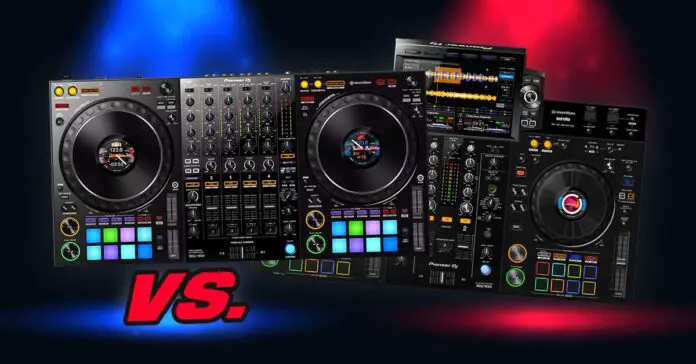Pioneer XDJ-RX3 and DDJ-1000 are currently among the most popular and widely used DJ controllers out in the market. They offer extensive feature sets and are both classified as high-end professional all-in-one DJ controllers. But which one is better for you? In this detailed comparison based on our sole experience we will focus on the most important features and use cases of both these devices to help you choose the right one for you!
- First – quick specs comparison
- 2 vs. 4 mixer channels
- The Pioneer XDJ-RX3 is a fully standalone device
- Mixer & Audio FX Differences
- Performance pads & Deck sections
- Jog wheels
- DJ software compatibility
- Good alternatives for the DDJ-1000 & XDJ-RX3
- Pros & Cons
- The Conclusion – Which one is better in the end?
This web portal is reader-supported, and is a part of the Amazon Services LLC Associates Program and the eBay Partner Network. When you buy using links on our site, we may earn an affiliate commission!
First – quick specs comparison
| Device: | Pioneer DDJ-1000 | Pioneer XDJ-RX3 |
|---|---|---|
| Photo: | 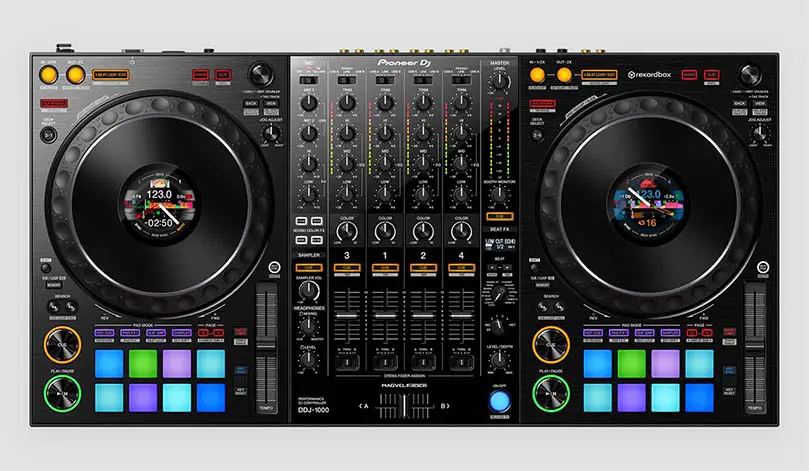 |  |
| Price: | – Check price on Amazon – Check price on Ebay | – Check price on Amazon – Check price on Ebay |
| Mixer Channels: | 4 | 2 |
| Standalone capabilities: | No, just a standalone audio mixer. | Yes, fully standalone unit. |
| Control layout: | Club layout. | Club layout. |
| Dedicated software: | Rekordbox (Serato DJ version available – DDJ-1000SRT). | Rekordbox, Serato DJ Pro. |
| Jog wheels: | Full size, mechanical. | Half-size, capacitive. |
| Audio FX: | 14 Beat FX, 4 Sound Color FX, +up to 16 customizable Pad FX. | 6 Sound Color FX, 14 Beat FX, +8 Pad Release FX, +on-screen FX controls. |
2 vs. 4 mixer channels
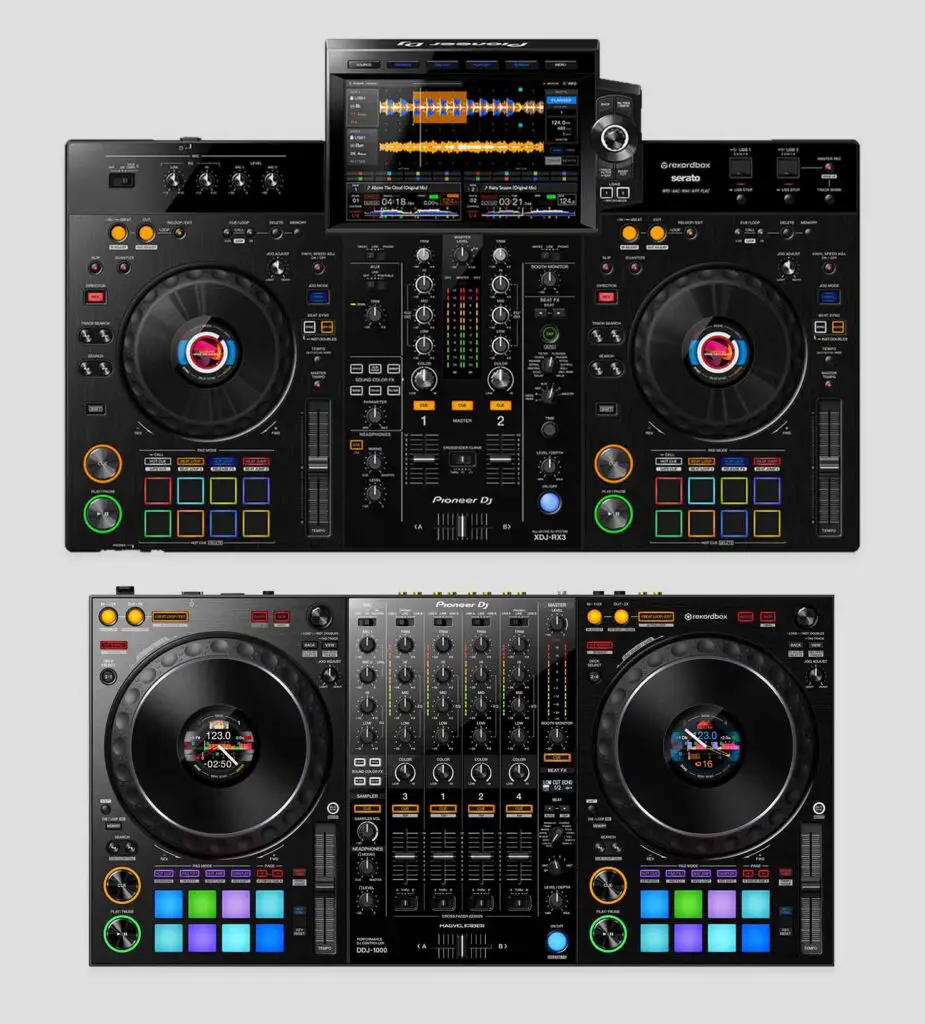
While the two devices don’t really differ that much in size, there are many potential deal-breaking differences between them in terms of their features. One of them has to do with the number of mixer channels available on each of them.
The Pioneer DDJ-1000 features 4 mixer channels. In essence, this is a great option for both people who tend to make use of all four mixer channels during their live mixes (for example for multi-channel mashups), and people who often use 3rd party audio devices with their DJ controllers and need separate mixer inputs for these.
Pioneer XDJ-RX3, features only 2 mixer channels, so if you’re used to mixing on 4-channel DJ controller and you want to use the unique feature set of the RX3, you will have to settle with some compromises.
Both devices feature 2 dedicated microphone inputs, although on the DDJ-1000 the mic audio is simply routed straight to the master output, while on the XDJ-RX3 you have access to a simplified microphone EQ and level adjustment setting panel on top of the device.
The Pioneer XDJ-RX3 is a fully standalone device
Yes, the Pioneer XDJ-RX3 is a fully standalone DJ controller and can be used live without being connected to a laptop. The only trick here is that if you want your track’s waveforms and metadata to show correctly, you’ll have to analyze your tracks in the Rekordbox DJ software before you begin your standalone DJ set.
With the Pioneer DDJ-1000, you will need a laptop with compatible DJ software to be connected to the DJ controller to perform. While the mixer on the DDJ-1000 can function in a standalone mode (act as a regular audio mixer with both the decks disabled completely), the controller itself doesn’t have all-in-one standalone mixing capabilities.
This is one of the reasons that the DDJ-1000 doesn’t feature a full-scale LCD display on the top panel, and settles with two small displays on the jog wheels. XDJ-RX3 on the other hand has a nice 10.1-inch touchscreen that enables you to efficiently manage your track library live (among other things).
Both DDJ-1000 and the XDJ-RX3 can work with Rekordbox DJ (and they unlock the full version of the software out of the box), but only the RX3 can support Serato DJ Pro (which it also unlocks by default).
The DDJ-1000 actually has an official Serato DJ Pro compatible counterpart – the Pioneer DDJ-1000SRT – be sure to check it out!
Check out our extensive comparison of the DDJ-1000 and its SRT version – there are more differences here than just the software compatibility matter!
See it here: Pioneer DDJ-1000 vs. DDJ-1000SRT (What Are The Differences?)
Mixer & Audio FX Differences

Both the controllers give you access to extensive sets of audio FX, but there are some important things to note here.
Pioneer DDJ-1000 doesn’t have the Sweep, Crush and Space effects in its Sound Color FX section. The XDJ-RX3 has all of these, besides the Pitch effect which is exclusive to the DDJ-1000 here.
On the RX3 used standalone or with Serato, you won’t have access to the two fully customizable Pad FX banks that are present on the DDJ-1000.
In total, there are 6 Sound Color FX and 14 Beat FX available on the XDJ-RX3 (+8 Release FX), and 14 Beat FX and 4 Sound Color FX on the DDJ-1000 (+up to 16 customizable Pad FX in two user banks).
On the Pioneer XDJ-RX3, you have a few additional ways to activate audio FX (such as using its main touchscreen). The device still has a nice unique selection of pad effects (labeled Release FX) which work really well in the standalone mode.
Performance pads & Deck sections
Performance pads are of almost exactly the same quality on both devices. The only thing that differs here is their visual appeal and the available pad modes.
One notable thing here, is that the Pioneer DDJ-1000 features two distinct pad modes that the RX3 doesn’t have – the Keyboard mode and the Key Shift mode. Both of these allow you to dynamically pitch your cue points and transpose your tracks during the live playback. This is not possible on the Pioneer XDJ-RX3 in the standalone mode.
Pads on the DDJ-1000 feature full surface RGB backlight, while the ones on the XDJ-RX3 – simple RGB backlight on their edges.
Jog wheels
The Pioneer DDJ-1000 wins in terms of the jog wheel size, and for many – in terms of their overall quality. This is because that while the XDJ-RX3 only features two half-size capacitive jog wheels, the DDJ-1000 has two full-size mechanical platters taken straight from the Pioneer CDJ-2000NXS player series!
The differences between capacitive and mechanical jog wheels are vast, so be sure that you pick the controller which will fit you the best in that matter!
Both the devices feature a dedicated jog wheel tension adjust knob on their front panels.
If you want a jog wheel experience at least a little bit closer to an actual Pioneer DJ club setup, you really should go for the DDJ-1000!
DJ software compatibility

As we’ve already mentioned before, the Pioneer XDJ-RX3 is compatible with Rekordbox and Serato DJ Pro out of the box. It will act as a hardware unlock device for both pieces of software, so you can try both of these out and use them without paying a dime!
When it comes to the Pioneer DDJ-1000, it’s only compatible with Rekordbox DJ software which it unlocks after being plugged into your laptop. However, there exists another official version of the DDJ-1000 made specifically for Serato DJ Pro – the Pioneer DDJ-1000SRT.
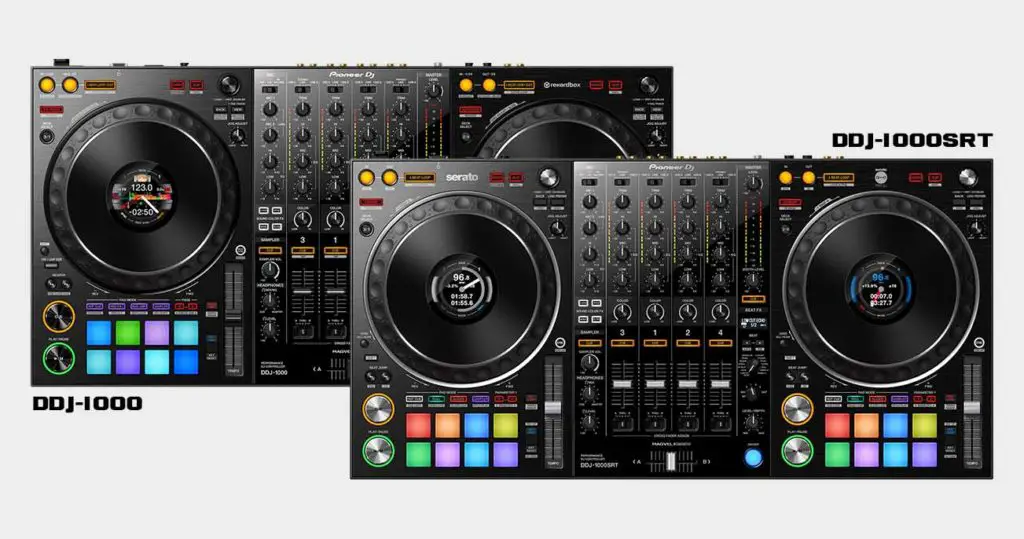
Both XDJ-RX3 and DDJ-1000 can be used with Virtual DJ software with an appropriate license, and provided you have a MIDI mapping for them – with Traktor.
Good alternatives for the DDJ-1000 & XDJ-RX3
Among the alternatives for these two leading DJ devices are both propositions from the Denon DJ Prime standalone line of DJ controllers and the Pioneer XDJ-XZ – an older, but in some places more feature packed cousin of the RX3.
If neither the XDJ-RX3, nor the DDJ-1000 is available for you right now, check out our list of similarly featured alternatives below!
- Denon DJ Prime 4 – a 4-channel fully standalone DJ controller from Denon – a direct competitor of the Pioneer XDJ-XZ and in a sense – the XDJ-RX3.
- Denon DJ Prime 2 – a 2-channel version of the Prime 4, closer to the XDJ-RX3 when it comes to its form factor.
- Pioneer DDJ-1000SRT – the Serato DJ Pro designated version of the DDJ-1000 that we mentioned a few times already.
- Pioneer XDJ-XZ – An older, but still very much capable 4-channel controller with 2-channel standalone capabilities – worth looking into!
Pros & Cons
Pioneer DDJ-1000
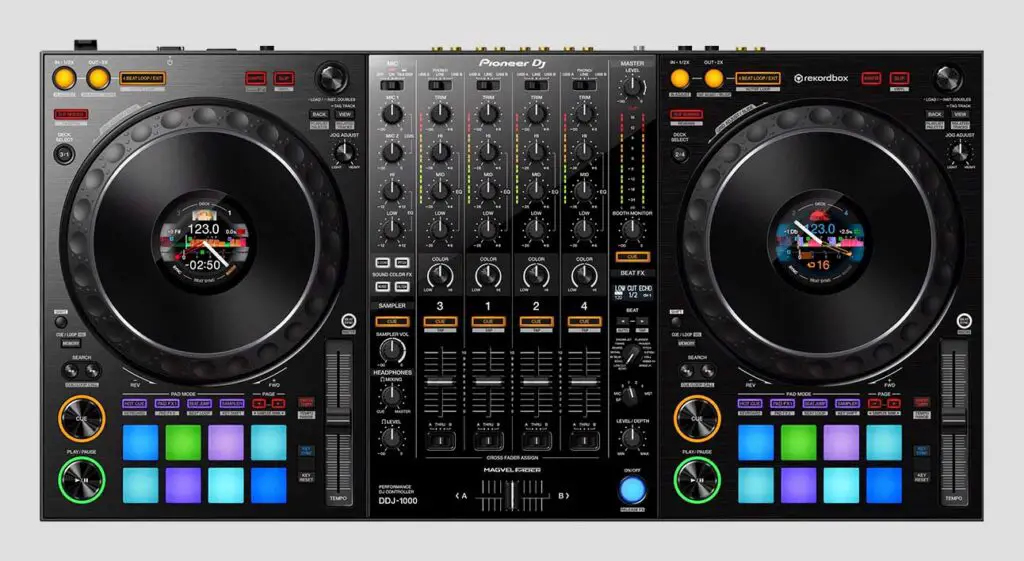
Pros:
- High-end professional DJ controller – a Pioneer DJ flagship device.
- Club layout resembling a CDJ x DJM mixer setup.
- Jog wheels based on the ones present on the Pioneer CDJ-2000 line of club DJ players.
- Great selection of audio FX and easy access to customizable Rekordbox Pad FX banks.
- Pitch-based FX accessible from the device’s performance pads.
Cons:
- Can’t function as a standalone DJ controller.
- Doesn’t support Serato DJ Pro software (the DDJ-1000SRT does).
- Lacks three of the Sound Color FX that the XDJ-RX3 features (Sweep, Crush and Space).
Pioneer XDJ-RX3
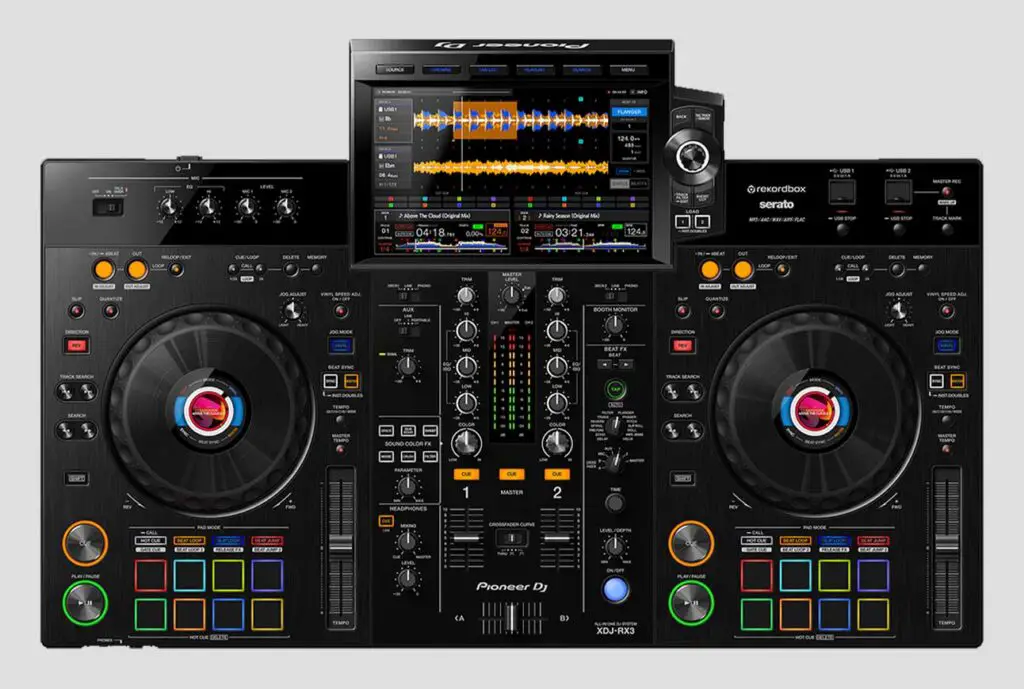
Pros:
- Standalone features + a 10.1 inch touch display.
- Supports both Serato DJ Pro and Rekordbox DJ software out of the box.
- Has 3 more Sound Color FX on board than the DDJ-1000.
- Gives you access to a few unique Release FX that are not available on the DDJ-1000.
Cons:
- Only 2 mixer channels on board.
- A little bit more bulky than the DDJ-1000.
- No pitch-based FX accessible in the Standalone Mode.
The Conclusion – Which one is better in the end?
So, which one of these should you choose? Well, it depends on quite a few things. The Pioneer DDJ-1000 will in general be better for those of you who actually need and use 4 mixer channels in their live sets, and who don’t need the standalone experience to get the most of their DJ controller.
The Pioneer XDJ-RX3 on the other hand, is a great choice for all those of you who’d like to have access to standalone features while still being able to use your DJ controller with your laptop, and can get over not having 4 channel mixer present on their device.
All in all, these controllers are high end equipment that can last you for years if treated right, and that will surely retain their resale value for a long time. You certainly won’t be disappointed with any of these!
Another thing to keep in mind, is that the upcoming release of the new flagship Pioneer DJ controller – the Pioneer DDJ-FLX10 is right around the corner! Depending on whether or not the leaks will prove themselves to be true, you might be interested in checking it out once its finally available on the market!
| Pioneer DDJ-1000 on Ebay: |
| Pioneer XDJ-RX3 on Ebay: |

